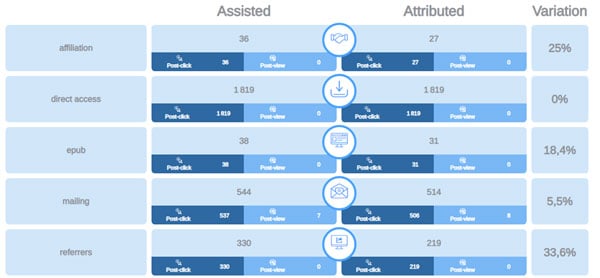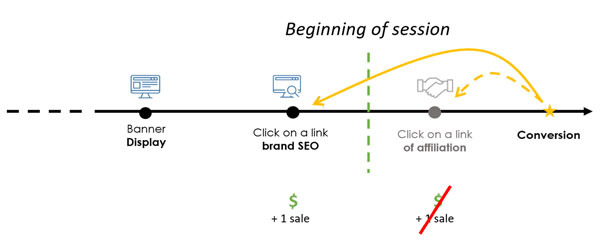Home > Blog > Tricks > Understand the need for your attribution to evolve
You may have realized that the complexity of your user journeys may require an evolution in your marketing attribution model.
Of course, your model may be perfectly suited to your media mix, brand, product and acquisition issues, despite the complexity of your journey (eg duration of your journey, number of interactions).
But it is also highly possible that, in order to more accurately value the performance of your campaigns, you had to go through the creation of a personalized single touch attribution model (or even a multi-touch attribution model), approaching the real contribution of each of your partners.
Attribution White Paper, understand the challenges. Download it now!
Here are some elements to direct your reflection in the evolution (or not) of your attribution model and, if necessary, the proportions of this change.
In our example, you are requesting for your online communication with several activation channels:
- a display partner for your acquisition campaigns,
- an affiliate partner to generate sales using discount codes,
- an actor of mailing to encourage the repurchase.
- Finally, you invest in SEA
You use an attribution model for your attribution at the last channel. Your quest for the perfect attribution model will initially lead you to study the notion of attendance.
THE ATTENDANCE, INDICATOR OF UNDER-VALORIZATION OR OVER-VALORIZATION OF MY CHANNELS
The attendance analysis of your partners (i.e. at least one interaction in the customer journey) can be done with your attribution model. You could thus compare their positions (or not) in the customer journey and get the first clues of the reality of your media mix.

Thus, by doing this analysis, you might find yourself facing this situation:
Although display is present on a large number of sales, your attribution model does attribute it only a few!
However, your affiliate and mailing partners are assigned the sale each time they participate in a conversion.
It would seem that your attribution model favors the performance of your mailing and affiliation partners. Mistake? Maybe not…
It may be that these two channels generate an engagement that does not generate the display.
However, this could also highlight a bias in your attribution. Indeed, such a short journey between a mailing or affiliation channel (respectively promotion and discount code) and conversion, could suggest that this session generating conversion was not necessarily the only one for the user.
To be certain, you could study the existence of a reading bias on your attribution model.
THE DELETION OF BIAIS, FIRST STEPS TOWARDS YOUR NEW ATTRIBUTION MODEL
To track this type of bias, you will try to compare your attribution model with a model deprioritizing the interactions in session (i.e. Deletion of the value of the touches occurring during the session to value the touches generating the session).
Why?
Your affiliate or mailing partners use communication methods that can modify the users browsing journey, to make them come back for a promotional code (to return just before confirming their purchase).
The marketing interaction, this detour, arrives at the last touch while the user had already made the decision to buy.
The attribution of a sale, in this case, should not attribute to this last touch but to the previous touch (the one which really made shift the user in “purchase” mode).

By eliminating this attribution bias, the number of sales attributed to your mailing and affiliate partners will drop significantly, to the benefit of your search communication. The display will eventually slightly increase.
The performance attributed to your search communication (mainly based on the brand), may suggest that your attribution model could also be subject to a brand bias (the brand cannibalize the other channels).
Indeed, the weight of your brand can be important. The user can arrive on the site simply by typing the name of your brand into a search engine. It is therefore just a path and not a conversion generator.
By also removing this bias, the number of sales attributed to the search drops strongly in favor of mailing and affiliation partners to a certain extent, but especially for the benefit of the display.

Thanks to these two approaches, you can identify two concrete axes to evolve your single-touch attribution model: deprioritize on the one hand the interactions in session, and on the other hand the interactions related to the branding.
WILL MY NEW ATTRIBUTION MODEL HELP MY MIX MEDIA?
If, with this new customized model, the difference between your attribution and the attendance of your channels still seems too important, it is probably that your channels do not all intervene in the same way on your user journeys.
Maybe your affiliate partner is converting (qualified) traffic that, in fact, has been generated by another channel.
Being able to accurately qualify the role of each of your channels is essential to fully understand the performance of each. It would be a shame to pay for an “opportunistic” channel (as in our previous example of affiliation) at the expense of a channel that generates quality traffic.
To set up a fairer compensation of the performance of each, it is therefore necessary to upstream identify the KPI on which it will be evaluated (ie generation of traffic, sales, repurchasing), involving either the creation of several models of single touch attribution or a move towards a multi-touch attribution model. This could allow you, in a near future, to highlight the performance of your actors, closer to your reality by attributing to each, a weight during a conversion.





